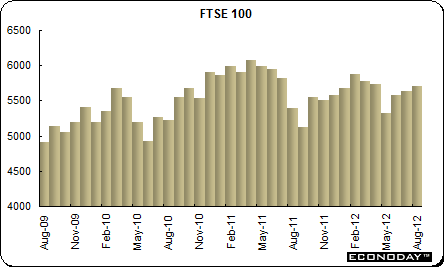London Stock Exchange
Although the London Stock Exchange celebrated its 200th anniversary in 2001, its history dates back to 1760 when 150 brokers were kicked out the Royal Exchange for rowdiness and formed a club to buy and sell shares. However, it was not until 1801 that it became a regulated Exchange. Fast forward to 1986 and the Big Bang when ownership of member firms by an outside corporation was allowed and many other rules were changed to make the Exchange more competitive. In 2000, the LSE became a public limited company and was listed in 2001. The Exchange offers many services including electronic trading. Competition between European and British markets is intense — and there is just a hint of national considerations in recent events. The criteria for EMU membership specifically address the impact on the City. This was the only test that passed in the recently completed assessment.
FTSE 100
The FTSE 100 Index is a capitalization-weighted index of the 100 most highly capitalized companies traded on the London Stock Exchange. The index was developed with a base level of 1000 as of January 3, 1984.

The FTSE plunged along with other major stock indexes as the credit crunch precipitated the mass shedding of financial stocks while plummeting commodity prices sent major energy and mineral company shares on a downward trajectory. However, the FTSE turned the corner in early March 2009 and the index gained enough to almost wipe out its 2009 losses. The FTSE was up 9.0 percent in 2010 but slid 5.6 percent in 2011. The FTSE was up 5.4 percent for the first two months of 2012. However, the index along with most major indexes declined in March (down 1.8 percent) and April (down 0.5 percent). The FTSE plunged in May (7.5 percent) along with most of the major equity indexes. However, the index rebounded in June (5.0 percent) and again in July (1.2 percent). It was up 1.4 percent in August.
|